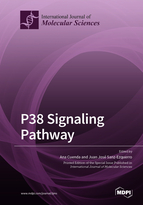P38 Signaling Pathway
A special issue of International Journal of Molecular Sciences (ISSN 1422-0067). This special issue belongs to the section "Molecular Biology".
Deadline for manuscript submissions: closed (31 July 2020) | Viewed by 55536
Special Issue Editors
Interests: signaling; p38MAPK; stress kinases; inflammation; cancer; MAPK
Special Issue Information
Dear Colleagues,
p38 Mitogen activated protein kinases (p38MAPK) are a group of four protein kinases, which are central for cell adaptation to environmental changes as well as for immune response, inflammation, tissue regeneration, and tumor formation. The p38MAPK family is composed of p38α, p38β, p38γ, and p38δ, p38α being the best characterized, whereas the study of the functions of p38β, p38γ and p38δ has been ignored by most publications. The interest in this group of protein kinases has grown continually since their discovery. Recent studies using new genetic and pharmacological tools are providing helpful information on the function of these stress-activated protein kinases and show that they have an acute impact on the development of prevalent pathologies related to inflammation, diabetes, neurodegeneration, and cancer.
In this Special Issue, we wish to offer a platform for high-quality publications on the latest advances on identification of p38MAPK substrates, functions, and regulation; the characterization of p38MAPK signaling networks and crosstalk; mechanisms underlying the role of p38MAPK in malignant transformation; and therapeutic opportunities associated with regulation of p38MAPK activity.
This issue will be of interest to basic researchers working in cell signaling and immunology and also to chemical biologists interested in drug discovery and clinicians.
Dr. Ana Cuenda
Dr. Juan José Sanz Ezquerro
Guest Editor
Manuscript Submission Information
Manuscripts should be submitted online at www.mdpi.com by registering and logging in to this website. Once you are registered, click here to go to the submission form. Manuscripts can be submitted until the deadline. All submissions that pass pre-check are peer-reviewed. Accepted papers will be published continuously in the journal (as soon as accepted) and will be listed together on the special issue website. Research articles, review articles as well as short communications are invited. For planned papers, a title and short abstract (about 100 words) can be sent to the Editorial Office for announcement on this website.
Submitted manuscripts should not have been published previously, nor be under consideration for publication elsewhere (except conference proceedings papers). All manuscripts are thoroughly refereed through a single-blind peer-review process. A guide for authors and other relevant information for submission of manuscripts is available on the Instructions for Authors page. International Journal of Molecular Sciences is an international peer-reviewed open access semimonthly journal published by MDPI.
Please visit the Instructions for Authors page before submitting a manuscript. There is an Article Processing Charge (APC) for publication in this open access journal. For details about the APC please see here. Submitted papers should be well formatted and use good English. Authors may use MDPI's English editing service prior to publication or during author revisions.
Keywords
- p38
- MAPK
- Signaling
- Inflammation
- Cancer
- Inhibitor
- Drug discovery
Related Special Issue
- P38 Signaling Pathway 2.0 in International Journal of Molecular Sciences (14 articles)







